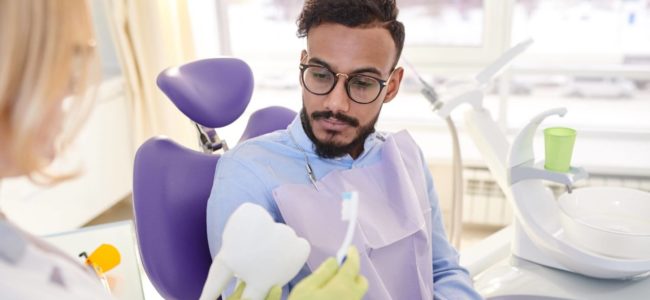What Causes Gingivitis?
Dentists always seem to warn against gingivitis, but what exactly is gingivitis? And how can you learn to recognize the signs, symptoms, and treatment options should you be diagnosed with gingivitis?
Gingivitis is a form of gum disease that causes inflammation of the gums because of a build-up of plaque. Gingivitis is a common dental hygiene problem, affecting 75% of Americans at some point in their lifetime. But, the good news is that gingivitis is highly treatable and even reversible with proper care and treatment.
Causes of Gingivitis
A buildup of the sticky, white substance known as plaque is the leading cause of gingivitis. Plaque is full of bacteria that contain toxins that are harmful and irritating to gums. These toxins may cause inflammation, redness, soreness, and even bleeding. While following a good dental hygiene regimen like brushing twice daily, and flossing daily should help you avoid gingivitis, there are other risk factors associated with gum disease. If you find yourself in any of the following high-risk categories, you’ll want to be extra vigilant about keeping gingivitis at bay.
- Smoking or Tobacco User- This is one of the greatest risk factors for gingivitis. Research shows that tobacco users are up to 7x more likely to suffer from gingivitis
- Poor Nutrition- Lack of nutrients through healthy foods starves the body of its natural ability to fight off diseases and infections.
- Medications- Lots of medications affect your oral health, and making sure your dentists know what medications you’re on can help them advise you better on any potential increased risk factors.
- Chronic Illness- Cancer, diabetes, and HIV all impact the body’s ability to fight off disease and infection. If you are managing any of these conditions, it’s best to let your dentists know.
Signs and Symptoms of Gingivitis
Just because you don’t feel any pain doesn’t mean that gingivitis isn’t a problem for you. Gingivitis affects many people, so not all symptoms will apply to your unique case. Understanding the range of possible symptoms will help you stay alert and focused on your oral health routine. If you’re experiencing any of these signs of gingivitis, it’s best to consult a dental professional immediately to see if you might be suffering from gingivitis.
- Red gums
- Swollen or puffy gums
- Bleeding gums
- Tooth pain or sensitivity
- Bad breath
- Loose teeth
- Sensitive teeth
- Changes in bite
- Dentures no longer fitting
- Pain when chewing
Treatment and Prevention of Gingivitis
Gingivitis does not have to be a serious condition, and can be managed and even reversed! This is why it’s crucial to get a diagnosis and treatment plan underway as soon as possible. A proper oral hygiene routine including daily brushing and flossing is essential. Additionally, cutting smoking also helps your chances of preventing or reversing gingivitis.
Using good, plaque-removing toothpaste and mouthwash can help reduce the amount of plaque on your teeth. Seeing a dentist regularly for routine cleanings will help manage the bacteria-causing plaque on your teeth as well. At these cleanings, dental hygienists test for gum disease by probing your mouth and gums using a tiny ruler to measure any inflammation along your gum line.
If you already have gum disease, there are many options to help fight gingivitis. Prescription mouthwash, oral antibiotics, and doxycycline can be effective treatment options for gingivitis. If your condition is more serious or has gone untreated, you might be looking at more serious solutions like oral surgeries to repair and heal the damage done by gingivitis.
Managing oral hygiene is the first line of defense against gingivitis. If you fall into any high-risk categories or think that you might, consult your dentist right away.
